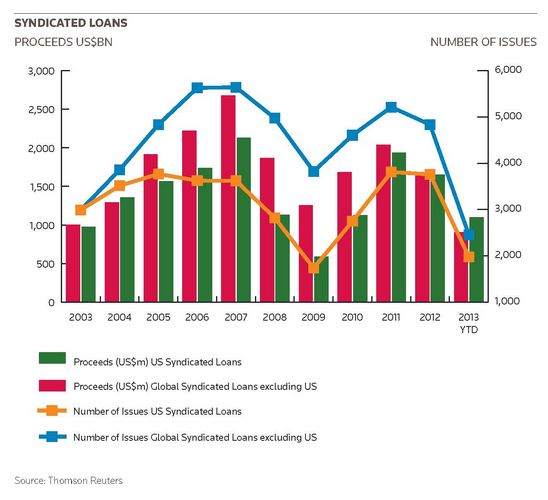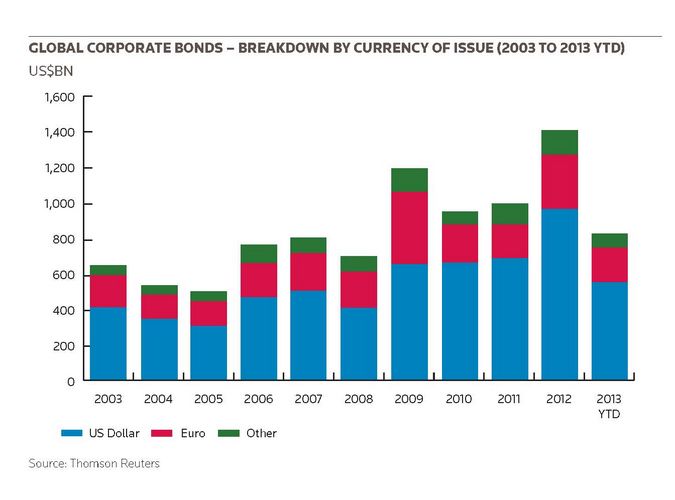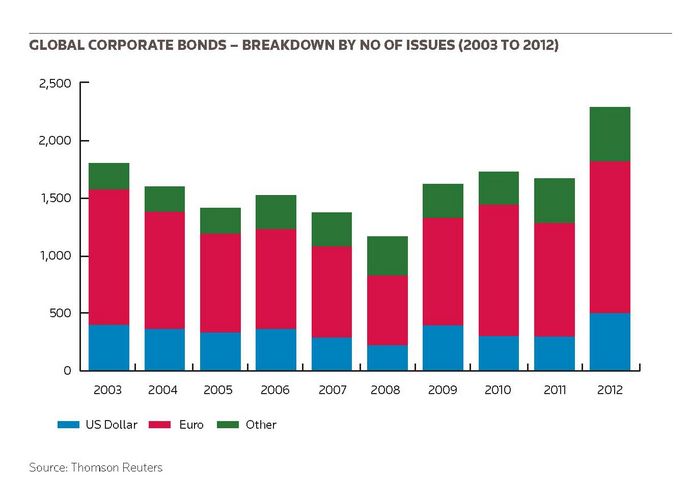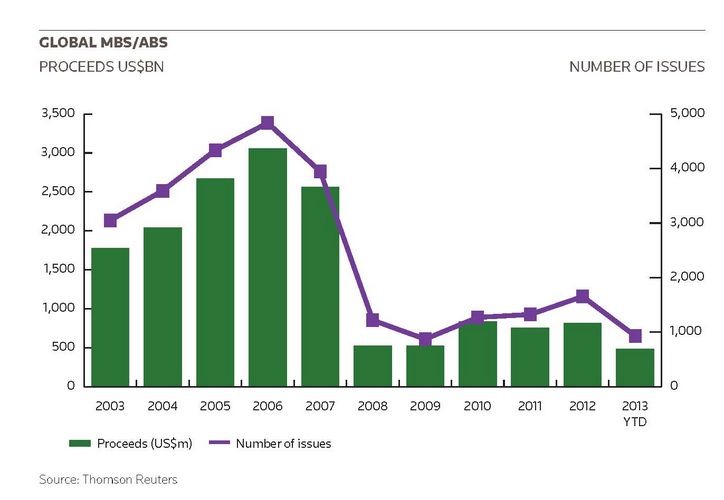To view the digital version of this report please click here.
To purchase printed copies or a PDF of this report, please email gloria.balbastro@thomsonreuters.com.
Ryan O’Grady, JP Morgan: Working closely with colleagues in the US and their deeper investor base means that you can broke bonds – I know that’s an undignified term – more effectively. You can create more liquidity. We don’t run a vastly bigger balance sheet in the US secondary trading business than we do in Europe. In fact, it’s probably bigger than Europe, so I think hopefully that addresses in part some of liquidity issues. I do wonder a little bit how, for example, post-trade transparency will go down in Europe. The notion of euro Trace [i.e. a European version of the FINRA Trade Reporting and Compliance Engine] is something a lot of market participants will be pretty uncomfortable with.
When you look, for example, at the way people take their risk in the US, because bonds are TRACE-able and CDS clearly isn’t we’ve seen a different dynamic in terms of what volumes have been done in each of those asset classes versus Europe where neither are reportable. I think Europe has a lot to contend with, but I do hope and I would fully support the notion that the buy side needs to continue to develop to respond to the challenge. They need to play their role.
Martin Egan, BNP Paribas: I’m dealing with regulators almost on a daily basis and they generally want simplification and more transparency. As a marketplace, we are where we are and it’s not going to change. So I think our business models will adjust. You will undoubtedly see much greater transparency.
Charlie Berman, Barclays: But do they want simplification? In terms of our day-to-day, In terms of a lot of the regulation they’re bringing, it is becoming more and more difficult to manage the dialogue between buy-side and sell side. There are more and more obstacles being put into place in terms of information exchange, price discovery and demand discovery because regulators don’t want us to operate in a way that is perceived to give one investor an advantage over another.
I think it goes to the heart of the way our market has evolved: we’ve had the 50th anniversary dinner for the creation of the Eurobond market and next year is the 15th anniversary of the introduction of the euro. Many of these conversations about whether we can compete with the US market, whether we are going to evolve like the US market, whether we need to get more credit savvy versus the US investor, I’ve been having for years.
I think Europe has come a long way but against that, in the last four years now, we’ve seen a complete fragmentation of the underlying investor base within domestic borders, which is a massive competitive disadvantage versus the United States. So in terms of this whole dynamic about whether Europe can mirror the structure of the US capital markets, I’d say at the moment clearly not.
Peter Charles, Citigroup: I think there are two issues though. I think there have been some encouraging signs around the globalisation of the investor base that Jim mentioned before, and the cross-sharing of knowledge. This is giving investors a willingness to step in and buy bonds in geographies that otherwise they might not necessarily have considered before.
To the regulatory point, the biggest concern, Charlie, you’re quite right, is we have this disconnect right now almost in the way that Europe is operating relative to the US which I think would be surprising to a lot of non-market participants as well as maybe to some market participants. But in many ways, the operating environment here in terms of the primary market is a lot tougher than it is in the US in terms of sharing information.
Charlie Berman, Barclays: Just like we don’t price things in the same way, we don’t as a community have the same practices between our institutions and it’s very, very evident that everybody’s doing pretty different things.
Demetrio Salorio, Societe Generale: To your point, Charlie, about the fragmentation of the European market, it’s happening but it’s a reflection of the current crisis. Don’t forget that Europe right now is in disarray. You have different markets evolving in different ways and different economies running at different speeds. So until we have a more stable and harmonious environment …
Charlie Berman, Barclays: It’s going to take years and years …
Demetrio Salorio, Societe Generale: … Absolutely. But I would like to come back to your point about how regulation is affecting demand in Europe. In Europe there is a lot of long-term demand but it’s now covered by sovereign debt. Why is that? Because the regulator overseeing investors, mostly insurance companies, is not designed to favour the acquisition of credit.
That’s a big problem. I don’t know if it’s on purpose or not, but regulators need to understand that certain asset classes such as infrastructure debt are extremely safe. If you look at historical losses, this is a perfectly fine asset class for insurance companies to hedge 25, 30-year liabilities. But it’s not going to happen. So we have a disconnect between policymakers asking private money to finance infrastructure and the reality of regulation, which is not backing it.
Jim Esposito, Goldman Sachs: To that point, I don’t think the European and US markets will ever be identical. I think one of the issues Europe is grappling with, going back to the point about if there’s going to be ongoing deleveraging, is the high-yield bond market that really needs to be a sustainable pool of capital.
A big difference between Europe and the US, particularly around the regulatory environment, is that Europe dissuades retail investors from participating in the loan product. In the US we’re talking about this loan-to-bond trend but make no mistake: the institutional loan product is hugely impactful on the US high-yield bond market.
It’s not just CLO issuance. There are big retail loan funds in the US. There’s nothing wrong with a retail investor participating in a loan. It’s a good product that looks and feels a lot like a floating-rate bond. So the idea that in Europe we’re trying to dissuade retail investors from participating in high-yield loans is a really constraining factor on the development of the high-yield bond market.
I think that would deepen the European high yield market materially and tap into demand that’s out there. Again, going back to my point, I think that’s actually a strength that Europe has compared to the US, and there’s this regulatory hurdle that to me doesn’t need to be there.
We need to develop a better institutional loan market in Europe, but one the retail investor can participate in. Whether it’s retail loan funds or various forms of ETFs, you get to a place where that could be a competitive advantage in Europe compared to the US. Interestingly, CVC recently priced an IPO for CVC Credit Partners European Opportunities Ltd [a loan fund that will invest in sub-investment grade European debt] that retail investors are able to participate in.
In the US, retail investors have grown up wanting to participate in the equity market. There’s a real equity culture at the retail level whereas in Europe retail investors grew up buying high-yielding government bonds and they have participated more in fixed-income product compared to the US. But for some reason we’re not moving that retail investor down the credit spectrum into what should be a good product: the floating-rate loan product.
Hakan Wohlin, Deutsche Bank: If European officials helped encourage more retail involvement in corporate bonds, Jim, it would be phenomenal. I believe retail would actually like to participate even more but as you said, it’s not being proactively encouraged but we’ll get there eventually. We’ve moved the needle a little but it’s really slow and cumbersome to change investment patterns. Also worth mentioning with regard to the US is the retail preferred market, which is a phenomenal market which hardly exists in Europe. There is a lot of untapped capacity.
Bryan Pascoe, HSBC: I think the problem on the retail side is regulation, which has scared banks away from approaching the true retail investor base in terms of a distribution channel. I think we’ve seen all sorts of developments around this recently in Europe and in Asia that from an internal perspective, around reputational risk and other areas need to be navigated when anything that’s considered to be of a retail nature is being considered.
New regulation and instances of mis-selling, whether it be Lehman mini bonds in Hong Kong or other issues that have emerged in the UK, make it very difficult for banks to get comfortable and really take the lead on developing retail product for sale directly to small investors in markets where the culture doesn’t already exist. It’s one of the key ways you can improve the depth of the European market but it will take a long time to develop further and should be generally focused on the highest quality borrowers which are easy to understand.
IFR: To that point, though, we have seen a lot of developments on stock exchanges all over Europe around fixed income. We haven’t seen a lot of capital-raising yet but a lot of exchanges have set up bond platforms. Might this unlock any potential, on the basis that regulated markets get around problems of transparency, lack of price discovery and the lack of regulated frameworks?
Peter Charles, Citigroup: I think for investment-grade product, that definitely has a place. The problem when you look at the development of those markets is that some of the names that have come either to the German or UK retail have played on their brand recognition. Whether the retail market is the appropriate place for them to be sold into is a real issue, I would say.
Martin Egan, BNP Paribas: Barriers from European and UK regulators to selling to retail will only become higher. So I think you’re right. In terms of investment-grade bonds, absolutely fine but in terms of a long-term source of liquidity for funding SMEs, for example, it’s not really an option. If you put an individual in a situation that is loss-making and it’s a simplified product, no problem at all. But if you start going down in terms of credit quality or any complexity in terms of a structured note, then you will have a lot to answer for.
Sandeep Agarwal, Credit Suisse: I think the problem with retail bonds is none have been priced fairly. Italian retail has provided a huge amount of liquidity to Italian issuers but if you look at asset pricing versus what is available elsewhere, you could argue that there is an arbitrage but the key concern is that there is no credit scrutiny in accessing the retail network directly. People argue that not even private banking is fairly priced today, let alone retail.
For an investor community that has no means of assessing [credit quality] other than through brand recognition as their main criterion, the mispricing issues are huge. So the mid cap sector needs to be intermediated with something, be it through a loan fund or the securitisation route, which in my view is a better route.
Perversely, retail understands the equity product better than it understands the fixed-income product where you can argue the loss possibilities are so much higher. But equities is a single product, whereas in bonds you’re talking about multiple tranches which you can’t really monitor individually; that’s the difference I suspect. So yes, it could work but you will need simultaneous institutional participation as a mandatory piece to create price tension.
IFR: I’d like to touch on emerging market issuance. Notwithstanding the rout we’ve seen in recent weeks, do you expect to see EM issuers increasingly tapping international capital markets or will domestic currency markets hold sway?
Hakan Wohlin, Deutsche Bank: Thank you for leading into that, Keith. I’m going to be a little provocative here and I’m probably going to be wrong but I think this time it’s different. So even though we’ll see pricing levels reset with the withdrawal of the artificial central bank induced ‘glut of plenty’, the fact is investors aren’t going to run away completely despite the fact that there’ll be quite a lot of unlevered pain on the way out.
We’ve all spent time in EM. The difference now vis-à-vis 10 or 20 years ago is there’s a lot more FX reserves on their balance sheets. A lot more is funded in local currencies, many countries’ debt-to-GDP is a lot stronger certainly vis-à-vis the euro zone periphery or even the United States. Growth rates are good albeit lower; current accounts in many cases are in surplus and often in better shape than many Western economies and there’s much more capital allocated from the investor side as well as better understanding on the investors side of EM as an asset class.
So despite the resetting pain that has made the headlines of the past few weeks and maybe will for the next months, I actually think the significant volume which could reach close to US$500bn this year (if we don’t completely fall off the cliff) may be US$1trn in three years. I think the world has changed and it’s very exciting for all of us because this area is making us very busy doing what we do best, namely raising capital.
Bryan Pascoe, HSBC: I agree that from a government perspective the sovereigns have done a very good job of lengthening their debt maturity profiles and of conducting liability management exercises to minimise their foreign currency exposure and switch back into local currency in many cases. But a lot of the local markets are still very driven by government and sovereign issuance and there’s a very limited credit culture, so from a bond market perspective the dollar or other international markets have been the only avenues.
That has kept issuance at the very high end; the large conglomerates or the well-known names so we need to accelerate the process of developing depth in local markets. I don’t think right now, with few exceptions, they have the structural ability to cope with developments from a corporate perspective. Either the maturities are too short or investor depth is quite simply insufficient and this is something that regulators and market practitioners must address proactively.
On the G3 side, EM had been one of the biggest beneficiaries of QE and the liquidity that’s come into the system. But because a lot of investors who typically would have bought investment-grade product had reached into EM to get additional yield, that’s been the first element they’ve sold because it wasn’t core to their investment parameters. But I think once yields drift up maybe to slightly higher levels then where they are now, it becomes a two-way risk proposition rather than a one-way bet. I think the market just needs a little bit of time to re-equilibrate itself around that.
Jim Esposito, Goldman Sachs: I agree with that. I think we’re all saying that the final destination this time around for the EM asset class is going to be better than prior periods of volatility. I think I’m probably in a camp where I think the journey to get there is probably still going to be a bit bumpier than what Bryan just described.
The reason I say that, just start with the data. In the last five years, the emerging markets have issued roughly US$1.3trn into the global capital markets across all hard currencies. In the prior five years, that number was just US$350bn. So the markets are deeper, balance sheets are absolutely better, debts been termed out, all of those are positives.
But that US$1.3trn that’s now sloshing around the system, I don’t think any of us are smart enough to really know where that went; I don’t think it went to bond heaven like an IBM bond might. So as that US$1.3trn re-circulates and perhaps finds more of a permanent home, that stock of debt that got issued compared to the US$350bn in the prior five years just strikes me as awfully big. So while we have had a pretty serious price adjustment, I wouldn’t want to predict just how much further price adjustment might be needed just given that US$1.3trn feels awfully big.
Martin Egan, BNP Paribas: That’s a very good point. The brutality of the sell-off has been very pronounced, like a good old-fashioned sell-off. I think it’s imperative, though, that the marketplace retains its attraction to emerging market borrowers but I think what’s happened should caution us that whatever instrument and product you’re in, you need a core investor base.
It’s pretty clear, especially in the EM space, that there’s a lot of fast money in play, and it’s struggling to cope with the market volatility. I think we’ll come back to a point where value will return but it reinforces the fact that the nature of many of our markets will remain very cyclical. We’ve had a very bullish trend; perhaps now we have to get used to a more challenging trend. But as market participants and practitioners, making sure that EM is open is key. It’s not helped, of course, by the lack of secondary market liquidity, but we need to make sure it’s efficient.
As Jim said, there’s a lot of inventory spinning around but it comes back to the point that you need your investor base in every instrument to be functioning. In some markets, such as the US market or the dollar market, it’s very mature. In other markets, it’s still immature. We need to work on the immaturity.
Peter Charles, Citigroup: I think we need to separate out very carefully the short term and the long term. I think clearly the emerging markets are going through a difficult re-adjustment but it’s even more painful than other global assets. But I think in the medium to long-term perspective, there’s no doubt that there will be growth in local currency funding and that will come from developments that Bryan suggested along the lines of the local investor base developing their capabilities.
But I think the international investor base will continue to be very important. Whether it’s via the Euroclear route in the rouble corporate market or use of GDNs, it’s clear that there are increasing instruments available for international investors to play in local markets. I think that’s going to continue to be very much a growth area, notwithstanding the current difficulties across markets.
Charlie Berman, Barclays: We’ve gone an hour and a half in this discussion and not mentioned the phrase ‘asset-price bubble’. I’m personally concerned about parallels with 1994 in the sense of everybody knew it was coming, everybody talked about it for two years: rates are going to rise etc etc but when it started, there wasn’t the orderly ‘well, we knew this was going to happen’ There was a complete puke; 1994 was, for those that remember it, probably one of the more traumatic and difficult years which put some firms out of business and a lot of others came close.
The starting point here is zero interest rates and unbelievably tight credit spreads – even after the correction that we’ve had now. I completely agree that the future for EM and other assets is very positive. I genuinely mean that, I think there is a real growth there, but I agree with Jim that the journey is going to be bumpy. On the liquidity point, investors may say: ‘we understand there isn’t the same level of liquidity now’ but [when things turn ugly], they still turn to us and say: ‘OK guys, where’s your bid’?
Claus Skrumsager, Morgan Stanley: On your credit spread point, Charlie, credit spreads are right in the middle of their 10-year band. They are not historically tight by any means. Rates are historically low, so it’s the unwind of a rate bubble. In 1994, policy rates went up by 300bp over a period of 12 months. What’s going to happen this time around is that the Fed is going to try desperately to avoid a 1994 scenario and will keep the front end very low for a very long time but will allow the back end to rise.
That will cause two things. That will mean when the selling subsides, sustaining short duration will be so painful carry-wise that you have to get back in there and equilibrium will establish itself and liquidity will be there. We’ve seen a correlation of rates assets since Ben Bernanke announced his tapering of QE, right? So the curve will go steep, that will help bank profitability as well, and this is on the back of a constructive growth outlook in the US. So I do think that this is different to 1994 and it is not a credit bubble, it is much more a rate bubble.
Hakan Wohlin, Deutsche Bank: I think we were a lot more leveraged in ’94. Although there’s some leverage in the system now, I think we’ll probably see more unlevered pain vis-à-vis what we saw back in ’94.
Charlie Berman, Barclays: Hang on, we started off by saying we haven’t even started deleveraging in Europe so I come back again to my original point: the environment we’re dealing with is a massively distorted environment where asset prices are supported by official holdings and actions. We haven’t talked about what happens when QE starts to really unwind. I hope you’re right, Claus. I hope your scenario, the steep yield curve etc, emerges.
What we didn’t have in 1994 was trillions of assets being held either directly or indirectly by central banks. Plus all of the assets still held on the balance sheets of the banks, which, let’s put it this way, may or may not be held at the correct price.
Giles Hutson, BofA Merrill Lynch: I don’t think these points are necessarily mutually exclusive. I think you’re talking about significant geographic differences. When we talk about lack of deleveraging, we’re really focusing on the European system. When we talk about an interest-rate bubble, we’re really focused on activities in the US There’s an increasingly big disparity between these two halves of the equation.
Peter Charles, Citigroup: But it’s very clear that the landing path for the central banks, and particularly the Fed, is incredibly challenging here.
Martin Egan, BNP Paribas: We all speak to central banks all over the globe. I remember 1994 vividly for a variety of mostly bad reasons. The market was closed for most of the year after February 4. I think [policymakers] are aware of the risks. Ben Bernanke’s comments in May were a stark reminder of what’s going to happen. The dangers and risks to the marketplace if things move too aggressively or too quickly are that they could destabilise us for a very prolonged period. They can’t take that risk.
So I think we should learn some lessons. I think the point from Claus is spot on as well. I don’t think our borrower client base appears to be awfully panicked at the moment around what’s going on. We have a re-pricing of risk and I think they’re taking a view that we’ve had this early stage of volatility and the road ahead will be rocky but the downside of a complete catastrophe – as 1994 was – is quite limited.
Demetrio Salorio, Societe Generale: Our investor clients don’t appear to be panicking either. Since this widening started, we’ve certainly had days when the markets haven’t been open for business but there have been others where we’ve been able to bring transactions. We are seeing investors at the right price and when conditions are more or less stable they’re coming back.
For sure, not everybody’s playing but I do believe that after five years of managing this crisis the investor community – and borrowers as well – have collectively developed a sense of how to deal with volatility. I don’t believe that we are going to see a shutdown of the marketplace; we’ll certainly need to adapt to this bumpy ride but things will calm down.
Jim Esposito, Goldman Sachs: I guess I agree with that, but bearing in mind, as we’ve all said, that there’s less leverage in the system today, the sell-off should be less violent. You couldn’t argue or debate that, but we’re probably in the final stage of what has been more than a five-year bull market for fixed-income securities. For the first time in ages, retail and institutional investors are going to see some major negative mark-to-market in their bond portfolios when they receive their quarterly statements.
Maybe there’ll be a slower-moving price adjustment than in the overly leveraged days but I don’t think we yet know how people are going to react when they start getting their bond statements in the mail and realise you can lose a lot of money when you own long-dated fixed-income securities, whether those are government bonds or emerging markets. To me this is more uncharted territory, and I would be careful to be overly confident or to predict just how big the price adjustments are going to be.
Martin Egan, BNP Paribas: I think it’s orderly versus disorderly. If we have a sell-off that’s orderly and you have a bit of backing off but the market’s open, fine. I think 1994 was completely disorderly and very poorly flagged.
Charlie Berman, Barclays: My point is I’m not expecting a 1994 but I do feel there is a level of complacency about where we are in the cycle and the challenges we’re facing. I wish policymakers and regulators were all-seeing and all-powerful. But they’re not.
Peter Charles, Citigroup: But I think the tapering can be managed reasonably effectively, and to your point, I think there’s a high awareness on the part of the Fed and other central banks as to how to manage that. I think the bigger challenge actually may come in 2015 – as now projected – when we start thinking about hikes in short-term official funding rates and how rapid that adjustment may be. I think that could actually end up causing even more volatility across markets than we will see with tapering.
Ryan O’Grady, JP Morgan: We’ve given a big focus here to what role the capital markets will play going forward. Do we all collectively think a bit of instability from that standpoint might not be such a bad thing in terms of compelling people to be more creative and more proactive in terms of how they finance their business? I’ll be honest: we did way more interesting business right across the board when the market was terrible. I’m not celebrating in any way the fact that clients were under more pressure but I think they were thinking much more critically and much more proactively about how they got things done.
Hakan Wohlin, Deutsche Bank: That’s an interesting point. If you extend that thinking to member states of the euro zone, [the back-up] actually may have a silver lining if the market offers a more accurate reflection of the risk you’re taking when you’re buying bonds in some of those sovereigns, right? I think [governments] had become a bit lazy in terms of their reforms etc so actually it may be a good thing that the market is re-pricing their risk.
Ryan O’Grady, JP Morgan: The central bank put probably still exists but it feels like they’ve re-struck it a lot more out-of-the-money. There may be outflows but I think the core people we sell our risk to are still going to be there. The core component seems quite composed and if anything is being selective about picking up risk at a much better price. The tourists are a lot more frazzled.
Sandeep Agarwal, Credit Suisse: I think any time you have liquidity withdrawal or a rate rise or a combination of the two, you’ve got to expect some level of destabilisation because there’ll be a level of uncertainty around it. I think we’re in a long-term rates rebalancing phase here with economic recovery. We have started talking about the Fed but we haven’t started talking about the European context, which will be next.
So some level of rate uncertainty is here to stay for a while. The only difference I see is that it will be against a backdrop of an improving macroeconomic environment and – potentially – improving confidence in the business sector as a whole because it will not be an inflation-led adjustment, but a growth-led adjustment.
That is probably the counterbalance here. I kind of agree that given the degree of severity of the dislocation we’ve had, this correction will be controlled, or at least there’ll be an attempt by the central bankers to make it a little bit more controlled than we think. But that has not stopped people from being speculative.
IFR: Bringing this wide-ranging conversation to a conclusion, I wanted to take it back to where we’re headed in DCM. Do you as a panel believe that we are about to enter a new DCM paradigm in terms of the bank funding conversation, the securitisation of specialised bank risk such as infrastructure, funding of mid-caps, and in terms of pricing and liquidity issues?
Hakan Wohlin, Deutsche Bank: I think everybody is saying that long term we are changing. Less banks, more capital markets.
Fabio Lisanti, UBS: Clearly the medium and long term trends are positive although paradigm shift is maybe too strong a term.
Jim Esposito, Goldman Sachs: I think it’s here. We’re in it already. It’s upon us.
Claus Skrumsager, Morgan Stanley: But the key issue is the lack of unification of the regulatory framework. That is needed to develop an SME market, that is needed to avoid pro-cyclical price developments. That’s the key theme: are the politicians really willing to drive unification hard and make sure it happens?
Fabio Lisanti, UBS: They have so many problems to deal with; that is just one of many. I think the unification of the markets will be something way in the future. We will have to live with developing trends. If you look at what’s happened in a lot of the insurance companies, yes, they’ve been buying long-dated assets but each and every one has a different format because of the different policy rates they put in their documents. So it’s fragmented; even new business is different in each and every country.
Re: infrastructure, there are many insurers putting together some very serious teams of infrastructure analysts to buy that asset class; same with real estate. A lot of investors did that in banks years ago so now we have a very sophisticated bank capital market. So there have been very informed developments in the investor base – and they’re not just listening to what the banks say what our research might say they’re very much forming their own opinions.
All of the asset classes you’ve mentioned – except some of the areas of speciality finance such as aerospace and shipping – have very much been the areas where long-dated investors have been investing resources and time.
Martin Egan, BNP Paribas: I’m definitely optimistic but I think we have to reinforce our community’s role in the equation. Our industry remains very much under pressure so I think we have to make sure that we reinforce the relevance of our institutions in the marketplace via liquidity and very smart solutions in an environment which is becoming more restrictive.
That’s probably one of the biggest challenges we face because some of the bright ideas we’ve had in the past may be less practical now. So we really need to reinforce the role we have in this equation because there is a risk that our role in the equation becomes diluted because of factors away from us.
IFR: Gentlemen: thank you very much for your insightful comments.
IFR New Styles for DCM Roundtable 2013: Participants






